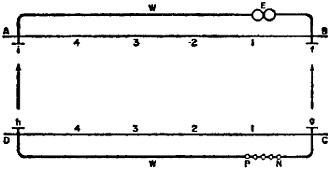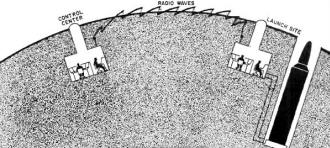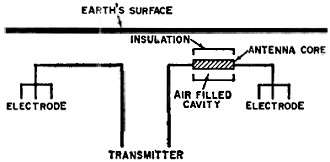|
January 1968 Popular Electronics
 Table of Contents Table of Contents
Wax nostalgic about and learn from the history of early electronics. See articles
from
Popular Electronics,
published October 1954 - April 1985. All copyrights are hereby acknowledged.
|
Benjamin Franklin is
credited with many inventions; scientific experiments and discoveries; writings
on science, government, and fiction; skills as an orator and diplomat; printer of
books and newspapers; business endeavors; and for being the nation's first Postmaster
General. Although we all are familiar with his forays into things electrical in
nature like flying kites in lightning storms, this article from a 1968 issue of
Popular Electronics introduces us to what might have been the earliest "wireless"
communications demonstration. The scheme involved the equivalent of the old lab
gag of charging up a large-valued electrolytic capacitor and then tossing it to
someone, resulting in a surprising shock. As with many of you, I have been both
the victim and purveyor of said mischief. In Franklin's case, the "wireless" medium
was water in a river, upon whose banks a pair of wires, each connected to two metal
plates, was erected. The capacitor used was in the form of a Leyden jar - akin to
the one used in his lightning experiment. Read on for the details.
The Mystery of Radio Waves That Travel Along or Beneath the Surface of the Earth
By Russell E. Adams, Jr.

In diagram drawn by Samuel Morse, AB and CD represent opposite
banks of a river; f, g, h, and i are copper plates (antenna); W indicates wires;
and PN and E are batteries and headphones respectively.
Although it is not common knowledge, the history of electrical communications
goes way back to 1748 - predating Samuel Morse's invention of the telegraph by almost
a hundred years. The actual credit for the first electrical communications system
can go to Benjamin Franklin.
On a spring-like day in late April, 1748, Benjamin Franklin held a picnic along
one bank of the Schuylkill River in Philadelphia. The guests present were entertained
with a series of electrical demonstrations, the first of which was the firing of
several guns-using an electric spark to ignite the charges. This was followed by
the electric-shock slaughtering of the turkeys for the picnic. The turkeys were,
in turn, roasted over fires that had been kindled with another electric spark.
As the afternoon drew to a close, Benjamin Franklin requested a volunteer from
among his guests. The volunteer was asked to place a hand on each of two metal plates
that had been nailed to the top of a table. A wire, connected to each plate, terminated
in the waters of the river.
Benjamin Franklin told his guests that an assistant was stationed on the opposite
bank of the river with a similar apparatus, and that when a signal was given, the
assistant would momentarily place a charged Leyden jar across the plates on his
apparatus. The signal was given, and the volunteer immediately jumped away from
the table - he had received a mild electric shock. The electric charge had traveled
from one bank to the other solely through the medium of water.
This was the first demonstration of "ground communications," but unfortunately,
Benjamin Franklin did not realize the full implications of his discovery.
It was not until many years later that ground communications was to become known
and successfully utilized.
Ground communications, as demonstrated by Benjamin Franklin,
depends on a physical flow of current (termed "ionic charge carriers") through a
conducting medium between the "transmitter" and the "receiver." A continuous conductive
medium is required, so that the atmosphere - a non-conductive medium, to say the
least - cannot be utilized to establish point-to-point ground communications.
Among the first experimenters with the ground communications phenomenon was Samuel
F.B. Morse. On December 16, 1842, he transmitted code messages from one side of
a river to the other without connecting wires. The diagram of his apparatus is shown
below; note the similarity between the diagram and the description of Franklin's
setup. Instead of a Leyden jar and human contact with the "receiver" side, Morse
used batteries (P and N denoting positive and negative) and headphones, denoted
by E.
Perhaps the earliest documented use of ground communications for transmitting
voice messages dates back to 1902. In that year, Nathan Stubblefield, an inventor
from Kentucky, broadcasted voice messages from the steamer Bartholdi to members
of Congress on the shore of the Potomac River - a distance of about a half-mile.
The military history of ground communications had its beginning
in the 46 early part of World War I. A French unit, trapped in the Argonne Forest
by a strong encircling force of Germans, was running low on ammunition and needed
reinforcements. But the encirclement was so complete that heavy losses would be
the price the main body of French troops would have to pay to mount a rescue. The
trapped unit, however, was in a position to observe the enemy forces. If up-to-the-minute
and steady communications could be established, it could turn the tide of battle.
Fortunately, a signalman with the trapped unit had heard of ground communications.
He constructed a "transmitter," using the field telegraph set and two bayonets driven
into the ground about six feet apart. A runner was sent through the German lines
with instructions for the French army to assemble a simple "receiver," consisting
of two bayonets and a pair of headphones. The subsequent flow of tactical information
coming from the trapped unit turned a nearly impossible situation into victory as
the French army suddenly broke through the enemy lines.
When the Audion tube was invented, the French learned that they could also use
ground communications techniques to intercept German telephone messages. At that
time, the German telephone system employed a single wire strung from station to
station, with the earth as the return current path to complete the circuit. Two
bayonets again became a pickup antenna, and an Audion amplifier and headphones were
the receiver. The grounded connections at the German telephone stations served as
the transmitting antenna electrodes.
Between World War I and about the mid-1950's, very little military research into
ground communications was conducted. But private and government research was stimulated.
During World War II, ground communications was utilized to a limited extent by radio
amateurs who had been forced off the air to make the spectrum space available for
military operations. The American Radio Relay League (ARRL) , an amateur radio organization,
conducted experiments with ground communications. The ARRL concluded, however, that
ground communications was much less efficient than radio.
Then, in 1948, the U.S. Bureau of Mines began to experiment with ground communications
transceivers in coal, iron, and salt mines. Primary communications were still relegated
to the field telephone, but in cave-ins, where phone lines were often cut by falling
rock, ground communications was intended to provide contact between rescue teams
and the trapped workers. A great deal of success was achieved with this system.
Perhaps the first serious attempt by the U.S. Department of
Defense to utilize ground communications began with the introduction of the nuclear
submarine. Since the new submarines were designed and built for long-term, deep-water
cruising, it was evident that the then current 50-foot maximum penetration depth
of VLF communications systems would be inadequate. For a nuclear submarine to communicate
via VLF, it would have to practically surface or release a floating antenna to receive
radio signals, putting the submarine in a vulnerable position.
The Navy's first ground communications experiments with submarines were held
at the Naval Air Station in Lakehurst, New Jersey. A dirigible was equipped with
a ground communications transceiver. Antenna electrodes were affixed to the transceiver
and dirigible in such a manner that they could be lowered into the water. The submarines
were equipped with similar equipment.
In the beginning, the tests indicated that greater-than-fifty-foot depths could
be achieved, but the transmission range was limited to a few miles - not enough
to satisfy the Navy's needs. However, enough progress was made each year to keep
the Navy interested. Whether such a system is operational at the present time is
not known.
Two accidental discoveries were made by the Navy during this research. It was
found that high-energy electrons oscillating from pole to pole generated about a
10-Hz signal that could be detected by the ground communications equipment, suggesting
the possibility of using ground communications as a means of detecting atmospheric
tests of nuclear weapons. It was also discovered that the system could be utilized
to detect cruising submarines. (The electrolytic action of the sea water on the
propeller and hull creates a d.c. field around the submarine, and as the propeller
turns, the lubricant on the shaft produces an intermittent circuit. The resulting
fluctuations in the d.c. field were easily detected.) While the situation that caused
detection could easily be remedied, the potential of ground communications as an
anti-submarine warfare weapon was demonstrated.

Radio waves from underground launch control center transmitter
travel along earth's surface. the Some of energy is reabsorbed into the earth and
picked up by underground launch site's receiving antenna.
The Air Force became interested in ground communications techniques
in 1958, during the height of the nuclear arms race. The ICBM's designed for delivering
nuclear warheads to the targets had to be protected against destruction, so they
were housed in "hardened" silos deep in the earth. This deep-earth silo setup gave
rise to another problem - that of jam-proof communications.
In July, 1958, Space Electronics Corporation (now Space-General Corporation,
a division of Aero-Jet General) was formed in California to investigate ground communications
for the Air Force. Instead of ionic charge carriers, low-frequency radio waves were
used to transmit the information from site to site. The system was based on a special
application of the wave equations formulated by Drs. A. Sommerfield and J. Zanneck,
wherein the angle of refraction of a radio wave can be controlled by the proper
selection of frequency.
Space Electronics Corporation utilized this principle in its experiments at Newport
Harbor, and later across the Glendale Grand-Central Airport, both in California.
The transmitter and receiver dipole antennas were buried less than 50 meters below
the surface of the earth (the silo centers were much deeper). Radio waves from the
transmitting antenna traveled toward the surface of the earth. The r.f. energy that
was not reflected back passed through the earth/air interface, or barrier, and continued
along the surface. As the wave front moved along the surface, it was constantly
attenuated, and some of the energy was reabsorbed into the earth to be intercepted
by the receiving antenna.
The system developed for the Air Force employed the "up-over-down" (UOD) technique.
Signals generated by the transmitter were detected by VLF receivers placed only
a few feet above the ground. The operating frequencies used for the tests were less
than 200 kHz, and the maximum distance achieved was less than 50 miles.
In February of 1961, the UOD system was adopted by the Air Force as a means of
providing underground communications between missile silos and launch control centers.
At the present time, this system is employed at all Minuteman missile bases, reportedly
saving some $300,000 per missile.

In the "up-over-down" system, the secondary wave is the primary
transmission path. The direct wave, attenuated by the earth through which it passes,
does not propagate very far.

Details of UOD transmitting dipole antenna.
Another method of ground communications, differing from the
UOD system in that radio signals are transmitted directly through the earth instead
of along the surface, was developed next. Normally, a through-the-earth system would
have a very limited range (less than a few hundred feet). If the antenna were placed
only a few meters below the earth's surface as in the UOD system, the relatively
high conductivity of the earth's crust would act like the metal shield of a coaxial
cable, rapidly attenuating the signal. However, the companies involved (among them
Raytheon and International Telephone and Telegraph) in the development of the new
system employed the wave guide principle. The geological structure of the earth
itself was used as a natural wave guide.
This geological structure has certain electrical properties that are quite similar
to those in man-made wave guides. From the earth's surface to a depth of between
700 and 1700 feet, the "crust" of the earth is a relatively good conductor. Below
this "crust" is a rocky layer (mostly non-conducting granite) that forms a part
of the Precambrian "basement complex," the thickness of which varies between 3500
and 6500 feet. A third layer that forms a part of the earth's "core" and extends
to a depth of greater than 16,500 feet is characterized by increasing conductivity
with increasing depth.
These three layers - crust, basement complex, and core - form a sandwich which
is not unlike a wave guide. Between the conducting core and crust, the basement
complex can be likened to the non-conducting air space inside a manmade wave guide.
Although the sandwich structure of the earth behaves in a manner similar to a man-made
wave guide, the non-conducting solid layer dampens signals to a much greater degree
than air.
In June, 1952, the Raytheon Corporation began experiments with this "deep rock
strata" communications system, in Brewster, Cape Cod. A 300-watt transmitter was
used; a narrow-band wave analyzer served as the receiver. Transmission distances
up to 1.1 miles were obtained for frequencies up to 10 kHz, but attempts to increase
that distance were unsuccessful. An examination of geological formations indicated
that long-distance transmissions were impractical in that region.
Additional experiments were conducted in the Adirondack Mountains, where the
formation of the basement complex was more favorable for long-distance transmissions,
and deeper holes could be drilled for the long resonant antennas. From these experiments,
Raytheon scientists concluded that transmission distances in the tens of miles were
practical.
The deep rock strata communications system has one unique advantage over both
the ionic charge carrier and UOD systems - the conductive overburden of the crust
forms a shield to natural and man-made interference.
In this modern age of communications satellites and lasers, ground communications
might seem to be out of place. But it can play an ever-increasing role in solving
unusual communications problems. For example, it can provide destruction-proof communications
networks for the Department of Defense. Based on ground communications techniques,
undersea radar may someday become a reality.
There is also the distinct possibility that ground communications may provide
the answer to over-the-horizon communications problems that will plague colonization
of the moon. Because the moon's radio horizon is so close, by comparison to that
of the earth, plus the absence of a radio-wave-reflective ionosphere, only two alternatives
are left for site-to-site communications. Moon-to-earth-to-moon relay and orbiting
lunar satellite. If, on the other hand, ground communications techniques can be
employed, this potentially vexing problem may be solved.
Posted August 22, 2019
|












